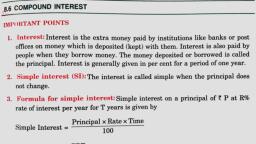Question 1 :
Is it possible to have an accelerated motion with a constant speed? Name such type of motion.<br>
Question 2 :
In uniform circular motion, the velocity vector and acceleration vector are:
Question 3 :
A boy is running along the circumference of a stadium with constant speed. Which of the following is changing in this case?
Question 5 :
(1) : When a rigid body is rotating about its own axis, all particles of that body have the same angular velocity.<br/> (2) : All particles of the body have the same time period.<br/>
Question 7 :
Uniform circular motion is called continuously accelerated motion mainly because its :
Question 8 :
Consider the following two statements A and B and identify the correct option:<br/>A) When a rigid body is rotating about its own axis at a given instant, all particles of body possess same angular velocity.<br/>B) When a rigid body is rotating about its own axis, the linear velocity of a particle is directly proportional to its perpendicular distance from axis.<br/>
Question 10 :
Circular Motion can be an example of periodic motion. <div>State whether the given statement is True or False.</div>
Question 11 :
The total energy of a particle that moves along a circular path in vertical plane is:<br/>
Question 12 :
A 60-kg person on a merry-go round is travelling in a circle with a radius of $3 \ m$ at a speed of $ 6 \ m/s$. What is the magnitude of the net force experienced by this person?
Question 14 :
Which one of the following is most probably not a case of uniform circular motion?
Question 15 :
Uniform circular motion is called continuously accelerated motion mainly because its :
Question 16 :
(1):In uniform circular motion, tangential acceleration is zero.<div>(2) : In uniform circular motion, velocity is constant.<br/></div>
Question 18 :
A car accelerates on a horizontal road due to the force exerted by
Question 19 :
If a particle moves in a closed path with a constant speed of 10 m/s, we can always say, that there will be a change in velocity.
Question 21 :
In a uniform circular motion, the angle between the velocity and acceleration is :
Question 22 :
A body crosses the topmost point of a vertical circle with critical speed. What will be its centripetal acceleration when the string is horizontal:
Question 23 :
A particles revolves along a circle with a uniform speed. The motion of the particle is ____ .
Question 24 :
Which of the following quantity remains constant in a uniform circular motion?<br>
Question 25 :
A particle is moving along a circle with uniform speed. The physical quantity which is constant both in magnitude and direction, is<br>
Question 28 :
In a uniform circular motion, the magnitude and direction of velocity at different points remain the same.
Question 29 :
Consider the following two statements A and B and identify the correct option:<br/>A) When a rigid body is rotating about its own axis at a given instant, all particles of body possess same angular velocity.<br/>B) When a rigid body is rotating about its own axis, the linear velocity of a particle is directly proportional to its perpendicular distance from axis.<br/>
Question 31 :
A particle is acted upon by a force of constant magnitude which is always perpendicular to the velocity of the particle. The motion of the particle takes place in a plane. It follows
Question 32 :
When a body moves with a constant speed along a circle:
Question 33 :
A particle moves along a circle with constant speed $2\,m{s^{ - 1}}$. If it completes $1/4th$ of rotation, change in its velocity as
Question 34 :
In Uniform circular motion direction of velocity is along the _______ drawn to the position of particle on the circumference of the circle. <br>
Question 36 :
For a particle in circular motion the centripetal acceleration should be
Question 37 :
Find the total acceleration of the point as a function of velocity and the distance covered.
Question 38 :
A car runs at constant speed on a circular track of radius 100 m taking 62.8 s on each lap. What is the average speed and average velocity on each complete lap? $(\pi\, =\, 3.14)$
Question 39 :
A pendulum is suspended from the roof of a rail road car. When the car is moving on a circular track the pendulum inclines.
Question 40 :
A shaft initially rotating at $1725$ rpm is brought to rest uniformly in $20s.$ The number of revolutions that the shaft will make during this time is<br><br>
Question 41 :
Assertion: Work done by friction force in case of pure rolling,is equal to change in rotational energy.
Reason: Ratio of kinetic energy of rotation to kinetic energy of translation is fixed for every case.
Question 42 :
When a force $F_1$ acts on a particle, frequency $6$Hz and when a force $F_2$ acts, frequency is 8 Hz. What is the frequency when both the force act simultaneously in same direction?
Question 43 :
Two particles move on a circular path (one just inside and the other just outside) with angular velocities $\omega $ and $ 5 \omega $ starting from the same point. Then:<br>
Question 44 :
Find the average acceleration between points A and B at an angular separation of $60^{\circ}$<br>
Question 45 :
A particle is moving in a circle of radius $R$ in such a way that at any instant the normal and tangential component of its acceleration are equal. If its speed at $t=0$ is $\displaystyle v_{0}.$ The time taken to complete the first revolution is
Question 46 :
A particle moves in a circle of the radius $25cm$ at two revolutions per second. The acceleration of the particle in $m/{sec}^{2}$ is
Question 47 :
Velocity of a particle varies as $\vec{V}=y\hat{i}-x\hat{j}$ under the effect of a single variable force. Then<br/>
Question 48 :
A pulley $1m$ in diameter rotating at $600 r.p.m.$ is brought to rest in $80\ s$. By constant force of friction on its shaft. How many revolutions does it moves?
Question 49 :
A merry-go-round, made of a ring-like platform of radius R and mass M. is revolving with angular speed $\omega$? A person of mass M is standing on it. At one instant., the person jumps off the<br>round, radially away from the center of the round (as seen from the round). The speed of the round afterwards is:
















































